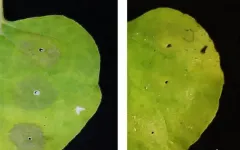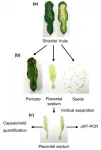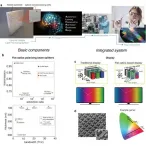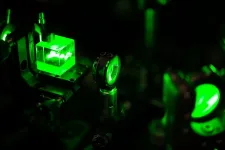Amyloid plaque mutation map opens new avenues for early detection of Alzheimer's disease
2021-03-09
(Press-News.org) A study published in the journal eLife made all the possible mutations in the amyloid beta peptide and tested how they influence its aggregation into plaques, a pathological hallmark of Alzheimer's disease.
The comprehensive mutation map, which is the first of its kind, has the potential to help clinical geneticists predict whether the mutations found in amyloid beta can make an individual more prone to developing Alzheimer's disease later in life.
The complete atlas of mutations will also help researchers better understand the biological mechanisms that control the onset of the disease.
"The genetic sequencing of individuals is increasingly common. As a result, we are finding more and more mutations, yet we lack the criteria to predict their outcome. Are they pathogenic and require intervention? Or are they neutral or benign?" says Benedetta Bolognesi, one of the lead authors of the study and Junior Group Leader at the Institute for Bioengineering of Catalonia, IBEC. "Specialists can use this map proactively to interpret the effect of a mutation so that when it is found in an individual we already know what it means and hopefully what to do. Similar maps have been built for the BRCA1 gene and breast cancer in the past and it is exciting we can replicate this for Alzheimer's disease."
According to Ben Lehner, ICREA Research Professor at the Centre for Genomic Regulation (CRG) and co-author of the study, "This is the first large-scale analysis and first comprehensive map of how mutations promote and prevent a protein to form amyloid fibrils, giving us unprecedented insight into this mechanism, which also represents the main therapeutic target in Alzheimer's disease".
Alzheimer's disease is the most common form of dementia, a neurodegenerative disease that affects more than 50 million people around the world. Many clinical trials have been performed worldwide but there is no known prevention or cure for the disease. The biological processes underlying Alzheimer's disease are associated with the deposition of protein clumps, also known as plaques or amyloid fibrils, in the brain. These plaques are mainly composed of the amyloid beta peptide (Aß) and their generation is toxic to neurons. In normal conditions amyloid beta peptides are soluble, but in the context of the disease they attach to one another, aggregating and forming long insoluble fibril clumps, in a process that once started is self-perpetuating.
Previous studies have shown that some inherited and particularly aggressive rare forms of Alzheimer's disease are caused by mutations in the gene encoding the amyloid beta peptide. Now researchers at the IBEC and CRG present the first comprehensive map of how mutations affect the formation of amyloid beta peptide plaques and influence the onset of Alzheimer's disease.
The researchers quantified all possible mutations in the amyloid beta peptide and how this influenced the formation of aggregates by using a cell-based high throughput system where the growth of cells depends on the aggregation of the different versions of Aß inside them. This allowed them to test the effects of more than 14,000 different versions of Aß in a single experiment.
This revealed that Aß42, the most abundant form of Aß peptide, has a modular organization; the aggregation rate can increase with mutations in the beginning of the peptide while it decreases when mutations occur in the final and hydrophobic region of the peptide. Researchers also found that the electric charge of the peptide plays an important role in preventing aggregation.
The researchers also looked at all fourteen known mutations in the Aß peptide that cause familial Alzheimer's disease, an inherited form of the disease. All fourteen of these mutations were found to increase the aggregation of the Aß peptide. According to the authors, this is a very important finding that suggests that the biochemical mechanism observed in this work is very similar, and maybe the same, as the one that causes the human disease.
"These mutations are extremely rare and underlie a relatively small number of cases of Alzheimer's disease. However, they will exist in someone who is currently alive on the planet and so we need to be able to predict the harmful ones that will cause Alzheimer's in some people. This can help us identify early in life the people that are likely to develop the disease so they can take action to prevent this, when this is possible" concludes Benedetta Bolognesi.
These fourteen known mutations are less than 4% of all the mutations that can occur in Aß. This new work measures the effects of more than 350 additional mutations in Aß , identifying those that accelerate the formation of aggregates and so the mutations that are most likely to cause Alzheimer's disease.
"We are now looking forward to building maps for other proteins that cause different neurodegenerative diseases like Parkinson's disease and to seeing the data from our atlas being used in the clinic," says Mireia Seuma, first author or the work and researcher at IBEC.
This project is a pilot study for a major international collaboration called the Atlas of Variant Effects (https://www.varianteffect.org/) that aims to characterise the effects of every possible mutation in the human genome and to identify and understand all the mutations that cause thousands of different diseases.
INFORMATION:
[Attachments] See images for this press release:
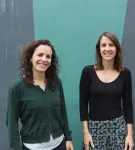
ELSE PRESS RELEASES FROM THIS DATE:
2021-03-09
While it's an unfair reality that women who develop gestational diabetes are ten times more likely to develop type 2 diabetes later in life, only a third of these women realise that they're at high risk, according to new research by the University of South Australia.
Conducted in partnership with the University College Dublin, the research examined the views of 429 Australian women with a history of gestational diabetes to establish their perceived risks of developing type 2 diabetes, potential barriers to losing weight, and useful strategies for supporting a healthy weight.
Lead researcher, UniSA's Kristy ...
2021-03-09
Tsukuba, Japan - Producing high-value pharmaceutical proteins in plants--sometimes called "molecular pharming"--offers advantages over some other manufacturing methods, notably the low cost and ease of scaling up production to meet demand. But expressing large quantities of "foreign" proteins in plants can also sometimes lead to problems, such as dehydration and premature cell death in the leaves.
Now a team led by Professor Kenji Miura of the University of Tsukuba has discovered that spraying leaves with high concentrations of the antioxidant ascorbic acid (vitamin C) can increase protein production three-fold or even more. They recently published their findings in Plant Physiology.
The team worked with a close relative of tobacco, ...
2021-03-09
The fossil in question is that of an oviraptorosaur, a group of bird-like theropod dinosaurs that thrived during the Cretaceous Period, the third and final time period of the Mesozoic Era (commonly known as the 'Age of Dinosaurs') that extended from 145 to 66 million years ago. The new specimen was recovered from uppermost Cretaceous-aged rocks, some 70 million years old, in Ganzhou City in southern China's Jiangxi Province.
"Dinosaurs preserved on their nests are rare, and so are fossil embryos. This is the first time a non-avian dinosaur has been found, sitting on a nest of eggs that preserve embryos, in a single ...
2021-03-09
For the first time, two researchers--one from the University of Copenhagen and the other from Columbia University--have accurately dated the arrival of the first herbivorous dinosaurs in East Greenland. Their results demonstrate that it took the dinosaurs 15 million years to migrate from the southern hemisphere, as a consequence of being slowed down by extreme climatic conditions. Their long walk was only possible because as CO2 levels dropped suddenly, the Earth's climate became less extreme.
A snail could have crawled its way faster. 10,000 km over 15 million years--that's how long it took the first herbivorous dinosaurs to make their way from Brazil and Argentina all the way to East Greenland. This, according to a new study by Professor ...
2021-03-09
Chili peppers (Capsicum spp.) are an important spice and vegetable that supports food culture around the world, whose intensity of its pungent taste is determined by the content of capsicumoids. However, the content of capsicumoids varies depending on the variety and is known to fluctuate greatly depending on the cultivation environment. This can be a big problem in the production, processing and distribution of peppers where sweet varieties can be spicy and highly spicy varieties are just only mildly spicy. It is thought that changes in the expression of multiple genes involved in capsaicinoid biosynthesis are involved in such changes in pungent taste ...
2021-03-09
When something bad happens to a child, the public and policy response is swift and forceful.
How could this have happened?
What went wrong?
What do we do to make sure it never happens again?
When a family becomes erroneously or unnecessarily enmeshed in the child welfare system, that burden is largely invisible - a burden borne mostly by the family itself.
In both situations, the fault for the systemic failure is often placed on the caseworker - overburdened, under-resourced, and forced to make quick and critical judgments about the risk ...
2021-03-09
In a new paper published in Light Science & Application, the group led by Professor Andrea Fratalocchi from Primalight Laboratory of the Computer, Electrical and Mathematical Sciences and Engineering (CEMSE) Division, King Abdullah University of Science and Technology (KAUST), Saudi Arabia, introduced a new patented, scalable flat-optics technology manufactured with inexpensive semiconductors.
The KAUST-designed technology leverages on a previously unrecognized aspect of optical nanoresonators, which are demonstrated to possess a physical layer that is completely equivalent to a feed-forward deep neural network.
"What we have achieved," explains Fratalocchi, "is a ...
2021-03-09
Obtaining a precise understanding of magnetic structures is one of the main objectives of solid-state physics. Significant research is currently being undertaken in this field, the aim being to develop future data processing applications that use tiny magnetic structures as information carriers. Physicists at Johannes Gutenberg University Mainz (JGU) and the Helmholtz Institute Mainz (HIM) recently presented a new method for investigating magnetic structures combining two different techniques. This allows to measure and map the magnetization as well as the magnetic ...
2021-03-09
For ice, so-called "surface melting" was postulated as early as the 19th century by Michael Faraday: Already below the actual melting point, i.e. 0 °C, a thin liquid film forms on the free surface because oft he interface between ice and air. Scientists led by Markus Mezger, group leader at the Max Planck Institute for Polymer Research (department of Hans-Jürgen Butt) and professor at the University of Vienna, have now studied this phenomenon in more detail at interfaces between ice and clay minerals.
In nature, this effect is particularly interesting in permafrost soils - i.e. soils that are permanently frozen. About a quarter of the land area ...
2021-03-09
The efficient provision of medical care is integral to society. Over time, the healthcare industry has tapped into modern technology in order to keep up its quality of service. This has, unsurprisingly, led to huge volumes of patient data. But it's not just patients whose data need to be stored; doctors, physicians, clinical staff, and even smart wearable gadgets are contributing to what is coming to be known as "healthcare big data."
Big data analytics (BDA), which involves the use of special design architectures to manage, store, and analyze complex data, is an important tool in healthcare. But it is hard to implement, owing to its high failure rate, resource-intensive process, and--most importantly--a lack of a clear guideline to aid practitioners. ...
LAST 30 PRESS RELEASES:
[Press-News.org] Amyloid plaque mutation map opens new avenues for early detection of Alzheimer's disease


